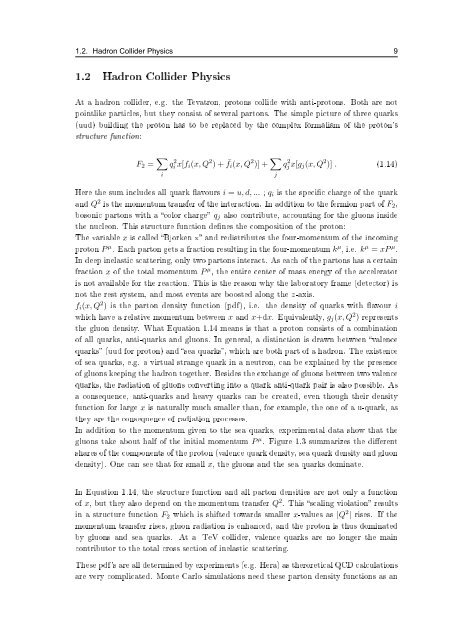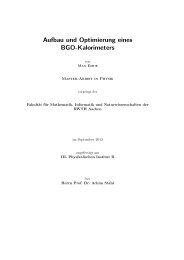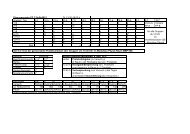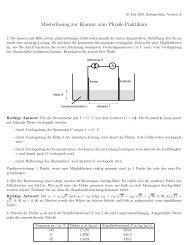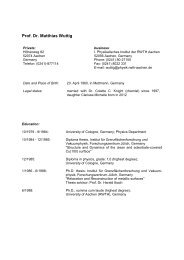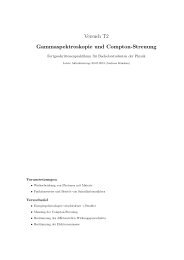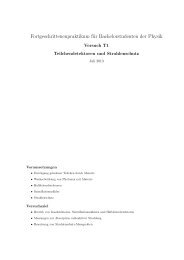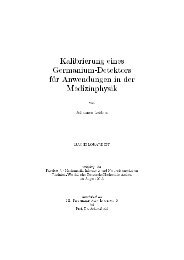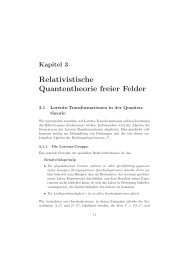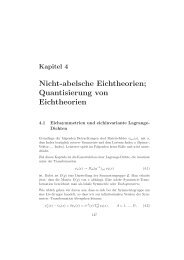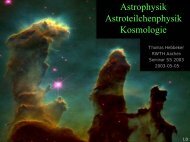Model Independent Search for Deviations from the Standard Model ...
Model Independent Search for Deviations from the Standard Model ...
Model Independent Search for Deviations from the Standard Model ...
Create successful ePaper yourself
Turn your PDF publications into a flip-book with our unique Google optimized e-Paper software.
1.2. Hadron Collider Physics 9<br />
1.2 Hadron Collider Physics<br />
At a hadron collider, e.g. <strong>the</strong> Tevatron, protons collide with anti-protons. Both are not<br />
pointlike particles, but <strong>the</strong>y consist of several partons. The simple picture of three quarks<br />
(uud) building <strong>the</strong> proton has to be replaced by <strong>the</strong> complex <strong>for</strong>malism of <strong>the</strong> proton's<br />
structure function:<br />
F 2 = ∑ i<br />
q 2 i x[f i (x, Q 2 ) + ¯f i (x, Q 2 )] + ∑ j<br />
q 2 j x[g j (x, Q 2 )] . (1.14)<br />
Here <strong>the</strong> sum includes all quark avours i = u, d, ... ; q i is <strong>the</strong> specic charge of <strong>the</strong> quark<br />
and Q is <strong>the</strong> momentum transfer of <strong>the</strong> interaction. In addition to <strong>the</strong> fermion part of 2 F 2 ,<br />
bosonic partons with a color charge q j also contribute, accounting <strong>for</strong> <strong>the</strong> gluons inside<br />
<strong>the</strong> nucleon. This structure function denes <strong>the</strong> composition of <strong>the</strong> proton:<br />
The variable x is called Bjorken x and redistributes <strong>the</strong> four-momentum of <strong>the</strong> incoming<br />
proton P . Each parton gets a fraction resulting in <strong>the</strong> four-momentum µ k , i.e. µ k µ = xP .<br />
In deep inelastic scattering, only two partons interact. As each of <strong>the</strong> partons has a certain<br />
µ<br />
fraction x of <strong>the</strong> total momentum P , <strong>the</strong> entire center of mass energy of <strong>the</strong> accelerator<br />
is not available <strong>for</strong> <strong>the</strong> reaction. This µ is <strong>the</strong> reason why <strong>the</strong> laboratory frame (detector) is<br />
not <strong>the</strong> rest system, and most events are boosted along <strong>the</strong> z-axis.<br />
f i (x, Q 2 ) is <strong>the</strong> parton density function (pdf), i.e. <strong>the</strong> density of quarks with avour i<br />
which have a relative momentum between x and x+dx. Equivalently, g j (x, Q 2 ) represents<br />
<strong>the</strong> gluon density. What Equation 1.14 means is that a proton consists of a combination<br />
of all quarks, anti-quarks and gluons. In general, a distinction is drawn between valence<br />
quarks (uud <strong>for</strong> proton) and sea quarks, which are both part of a hadron. The existence<br />
of sea quarks, e.g. a virtual strange quark in a neutron, can be explained by <strong>the</strong> presence<br />
ofgluonskeeping<strong>the</strong>hadrontoge<strong>the</strong>r. Besides<strong>the</strong>exchangeofgluonsbetweentwovalence<br />
quarks, <strong>the</strong> radiation of gluons converting into a quark anti-quark pair is also possible. As<br />
a consequence, anti-quarks and heavy quarks can be created, even though <strong>the</strong>ir density<br />
function <strong>for</strong> large x is naturally much smaller than, <strong>for</strong> example, <strong>the</strong> one of a u-quark, as<br />
<strong>the</strong>y are <strong>the</strong> consequence of radiation processes.<br />
In addition to <strong>the</strong> momentum given to <strong>the</strong> sea quarks, experimental data show that <strong>the</strong><br />
gluons take about half of <strong>the</strong> initial momentum P . Figure 1.3 summarizes <strong>the</strong> dierent<br />
sharesof<strong>the</strong>componentsof<strong>the</strong>proton(valencequarkdensity, µ seaquarkdensityandgluon<br />
density). One can see that <strong>for</strong> small x, <strong>the</strong> gluons and <strong>the</strong> sea quarks dominate.<br />
In Equation 1.14, <strong>the</strong> structure function and all parton densities are not only a function<br />
of x, but <strong>the</strong>y also depend on <strong>the</strong> momentum transfer Q . This scaling violation results<br />
in a structure function 2 F 2 which is shifted towards smaller x-values as |Q 2 | rises. If <strong>the</strong><br />
momentum transfer rises, gluon radiation is enhanced, and <strong>the</strong> proton is thus dominated<br />
by gluons and sea quarks. At a TeV collider, valence quarks are no longer <strong>the</strong> main<br />
contributor to <strong>the</strong> total cross section of inelastic scattering.<br />
Thesepdf'sarealldeterminedbyexperiments(e.g. Hera)as<strong>the</strong>roreticalQCDcalculations<br />
are very complicated. Monte Carlo simulations need <strong>the</strong>se parton density functions as an


